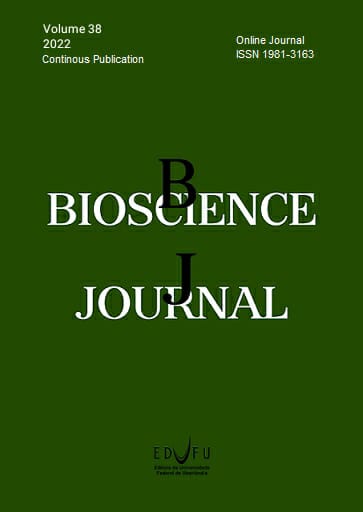Deposition of diquat with different spray tips, efficiency on common water hyacinth, and effect on water quality
DOI:
https://doi.org/10.14393/BJ-v38n0a2022-53608Keywords:
Eichhornia crassipes, Herbicide, Reward, Spray Technology, Water plant.Abstract
Eichhornia crassipes, known as common water hyacinth, has a high growth rate and produces large amounts of biomass when there are imbalances in water bodies, making it one of the worst aquatic weeds in the world. A study was carried out under small water reservoir field conditions to evaluate the herbicide diquat (960 g ha−1) in controlling this species, at the adult stage development. Four spray tips (AI 11002VS, XR 11002VS and, TXVK-8 with spray volume of 200 L ha−1 and XR 11003VS with 400 L ha−1) were tested. Spraying was performed using a CO2-pressurized sprayer under constant pressure attached to a boat. Plant control was visually evaluated at 1, 3, 7, 11, 14, 21, 29, 60, 87, and 98 days after herbicide application and dry matter accumulation was determined at the end of the experimental period, as well as the spray solution deposition in the application area and water physical and chemical quality. The herbicide diquat was efficient in controlling E. crassipes plants at the dose applied and in development stage of the studied plants, regardless of the type of spray tip at the end of the evaluations. At the beginning of evaluations, the spray tip XR 11002VS was the least effectivity in controlling water hyacinth plants. Spray solution losses were high in all tips tested for control of E. crassipes plants, and the spray tips AI 11002VS and XR 11003VS provided the lowest losses during spraying. No water physical or chemical characteristics were negatively affected by diquat application.
References
CARDOSO, L.R., MARTINS, D. and TERRA, M.A. Sensibilidade a herbicidas de acessos de aguapé coletados em reservatórios do estado de São Paulo. Planta Daninha. 2003, 21(Edição Especial), 61-67. http://dx.doi.org/10.1590/S0100-83582003000400009
COSTA, N.V., et al. Efeito de pontas de pulverização na deposição e na dessecação em plantas de Brachiaria brizantha. Planta Daninha. 2008, 26(4), 923-933. http://dx.doi.org/10.1590/S0100-83582008000400025
COSTA, N.V., MARTINS, D., RODELLA, R.A. and RODRIGUES, A.C.P. Alterações anatômicas do limbo foliar de plantas de Polygonum lapathifolium submetidas à aplicação de herbicidas. Planta Daninha. 2011, 29(2), 287-294. http://dx.doi.org/10.1590/S0100-83582011000200006
DOMINGOS, V.D., MARTINS, D., COSTA, N.V. and MARCHI, S.R. Fatores ambientais na distribuição de populações de Brachiaria subquadripara presentes no reservatório de Barra Bonita/SP. Planta Daninha. 2011, 29(1), 37-49. http://dx.doi.org/10.1590/S0100-83582011000100005
GICHUKI, J., et al. Water hyacinth Eichhornia crassipes (Mart.) Solms-Laubch dynamics and succession in the Nyanza Gulf of Lake Victoria (east Africa): implications for water quality and biodiversity conservation. Scientific World Journal. 2012, 2012, 1-10. http://dx.doi.org/10.1100/2012/106429
HODGESON, J.W., BASHE, W.J. and EICHELBERGER, J.W. Method 549.1 ¬ Determination of Diquat and Paraquat in Drinking Water by Liquid-Solid Extraction and High Performance Liquid Chromatography with Ultraviolet Detection. IN: U.S. Environmental Protection Agency. Methods for the Determination of Organic Compounds in Drinking Water. Supplement II, EPA/600/R-92/129. Cincinnati, Ohio: Environmental Monitoring Systems Laboratory, 1992.
HUSSNER, A., et al. Management and control methods of invasive alien freshwater aquatic plants: A review. Aquatic Botany. 2017, 136, 112-137. https://doi.org/10.1016/j.aquabot.2016.08.002
KUVA, M.A., SALGADO, T.P. and REVOREDO, T.T.O. Experimentos de eficiência e praticabilidade agronômica com herbicidas. In: MONQUERO, P.A. (Org.). Experimentação com herbicidas. São Carlos: RiMa Editora, 2016.
MARCHI, S.R., et al. Efeito de pontas de pulverização e arranjos populacionais de plantas de Eichhornia crassipes e Salvinia auriculata na deposição da calda de pulverização sobre plantas de Pistia stratiotes. Planta Daninha. 2009, 27(2), 389-396. http://dx.doi.org/10.1590/S0100-83582009000200023
MARCHI, S.R., et al. Deposição de calda de pulverização sobre plantas de salvínia em função de pontas de pulverização e arranjos populacionais entre plantas de aguapé e alface d'água. Planta Daninha. 2011, 29(1), 77-84. http://dx.doi.org/10.1590/S0100-8358201100010001
MARTINS, D., VELINI, E.D., NEGRISOLI, E. and TOFOLI, G.R. Controle químico de Pistia stratiotes, Eichhornia crassipes e Salvinia molesta em caixas d'água. Planta Daninha. 2002, 20(Edição Especial), 83-88. http://dx.doi.org/10.1590/S0100-83582002000400010
MARTINS, D., VELINI, E.D. and NEGRISOLI, E. Controle de Egeria densa e Egeria najas em caixa d'água utilizando o herbicida diquat. Planta Daninha. 2005, 23(2), 381-385. http://dx.doi.org/10.1590/S0100-83582005000200029
MARTINS, D., VELINI, E.D., COSTA, N.V. and SOUZA, G.S.F. Manejo químico de Eichhornia crassipes e Brachiaria subquadripara com diquat em condições de reservatório. Planta Daninha. 2011, 29(1),51-57. http://dx.doi.org/10.1590/S0100-83582011000100006
MUDGE, C.R. and NETHERLAND, M.D. Response of giant bulrush, water hyacinth, and water lettuce to foliar herbicide applications. Journal of Aquatic Plant Managenment. 2014, 52(1), 75-80.
MUDGE, C.R. and NETHERLAND, M.D. Response of water hyacinth and nontarget emergent plants to foliar applications of bispyribac-sodium alone and combination treatments. Journal of Aquatic Plant Managenment. 2015, 53(1), 7-12.
NEGRISOLI, E., MARTINS, D., VELINI, E.D. and FERREIRA, W.L.B. Degradação de diquat em condições de caixa d’água com e sem plantas de egéria. Planta Daninha. 2003, 21(Edição Especial), 93-98. http://dx.doi.org/10.1590/S0100-83582003000400014
NOGUEIRA, H.C., ANTUNIASSI, U.R. and VELINI, E.D. Avaliação de pulverizadores utilizados para aplicação de herbicidas em ferrovias do Brasil. Energia na Agricultura. 2001, 16(1), 71-86.
PITELLI, R.A., BISIGATTO, A.T., KAWAGUCHI, I. and PITELLI, R.L.C.M. Doses e horários de aplicação de diquat no controle de Eichhornia crassipes. Planta Daninha. 2011, 29(2), 29-277. http://dx.doi.org/10.1590/S0100-83582011000200004
SBCPD. Procedimentos para instalação e avaliação e análise de experimentos com herbicidas. Londrina: SBCPD, 1995. 42p.
SOUZA, G.S.F., CAMPOS, C.F., PEREIRA, M.R.R. and MARTINS, D. Influência da chuva na eficiência de diquat no controle de Salvinia auriculata, Pistia stratiotes e Eichhornia crassipes. Planta Daninha. 2011, 29(4), 923-928. http://dx.doi.org/10.1590/S0100-83582011000400023
WERSAL, R.M. and MADSEN, J.D. Combinations of diquat and carfentrazone-ethyl for control of floating aquatic plants. Journal of Aquatic Plant Managenment. 2012, 50(1), 46-48.
Downloads
Published
Issue
Section
License
Copyright (c) 2022 Sidnei Roberto de Marchi, Ricardo Fagundes Marques, Dagoberto Martins

This work is licensed under a Creative Commons Attribution 4.0 International License.





